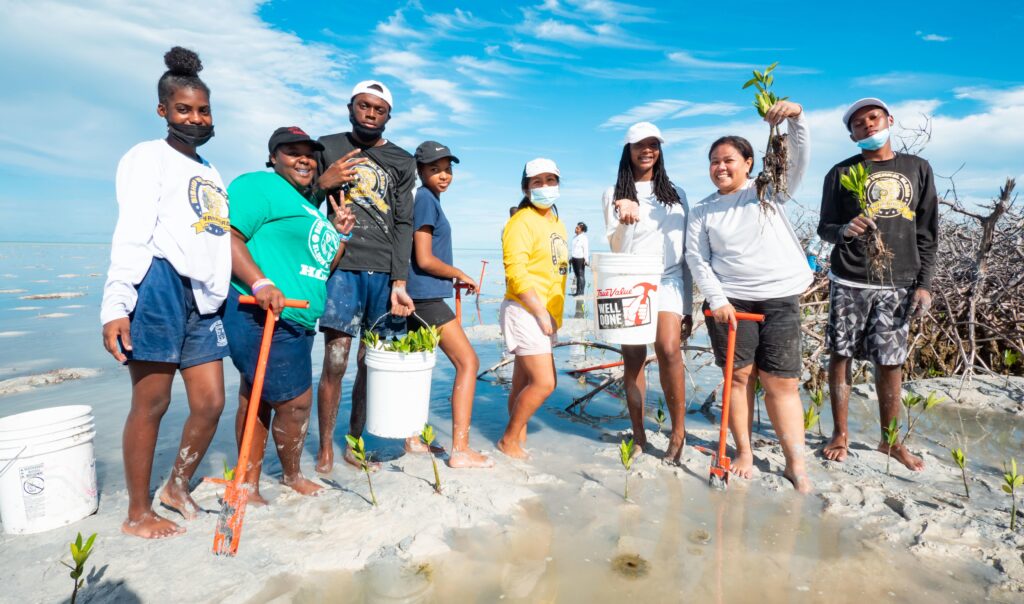Grand Bahama students help plant 2,200 Mangroves, Bonefish & Tarpon Trust, BNT, Mang Gear & Volunteers Partner in Habitat Replacement after Dorian
With the sun on their backs and the future of their island at heart, dozens of students from Bishop Michael Eldon High School planted 2,200 mangroves in East Grand Bahama recently, helping to restore what Hurricane Dorian destroyed two years earlier.
Students clambered over naked wetlands where red mangroves had flourished before being wiped out by the Category 5 hurricane that leveled entire settlements in Abaco and flooded much of Grand Bahama. Bonefish & Tarpon Trust (BTT), a Florida- and Bahamas-based conservation organization working with other non-profits after the passage of the storm, helped organize the planting activity after originally assessing Grand Bahama’s loss of mangroves. BTT called that assessment “sobering.”
“An area of 91 square kilometers (56.5 miles) was damaged or destroyed, including nearly 74% of the area covered by mangroves in Grand Bahama and 40% on Abaco,” said Justin Lewis, BTT’s Bahamas Initiative Manager. “These mangroves could take a decade or more to recover on their own. And in the most severely impacted locations, sites where seed banks were blown out, they may not recover at all. This project will help jumpstart the natural recovery process.”
The loss threatens the habitat of fish, conch, crawfish and birds.
“Mangroves are not only nurseries for many species, they also act as buffers against a storm or rising waters, help to stave off coastal erosion and can save human lives by being a barrier that absorbs and lessens the impact of oncoming wind and waves,” said Lewis.
Scientists have credited mangroves with saving Grand Bahama, in particular, from suffering even greater damage, one researcher calling it a natural sacrifice and trade-off, and others saying that understanding the extent of protection they provided makes the replanting even more urgent.
Students who planted the mangrove seedlings, worked with teachers under the guidance of Lewis, along with representatives from the Bahamas National Trust and MANG GEAR. Their recent volunteer work is part of an ambitious 5-year campaign called the Northern Bahamas Mangrove Restoration Project aimed at planting 100,000 mangroves in areas hardest hit by Dorian. In Abaco, Friends of the Environment is partnering in the campaign. The project, which started in December 2020, but was hindered by COVID restrictions, is nearing the 20% mark of its goal.
The project also provides students the opportunity to learn more about the vital role that mangrove forests play in coastal ecosystems and the importance of conserving them, Lewis explained. “Classroom education is essential, of course, but you really can’t replace the value of the hands-on experience the students get from the planting. The experience reinforces the importance of the ecosystem, and enables the students to become better advocates for conservation.”
He stressed the power of partnership.
“While immediate attention following the devastating storm focused on basics of food and shelter followed by infrastructure, we have been working with our partners to rebuild nature’s infrastructure,” explained Lewis. “BTT could never have done this alone. It is a true partnership with the Bahamas National Trust, MANG GEAR, Friends of the Environment and the many volunteers who show up any time we announce a planting because they understand how important mangroves are to the coastlines and the wetlands of The Bahamas.”
Among the most valuable assets protected by mangroves are bonefish, the slippery, clever dodgers known as the gray ghost of the flats because of their ability to avoid capture. Protected by legislation, bonefish are the center of attraction in a catch-and-release sport that adds $169 million to the economy annually in lodging, food, boat rentals, bonefish guide fees and more. The large-scale mangrove restoration project will breathe new life into severely damaged mangrove habitat, which is critical to the well-being of the species and the overall health of The Bahamas’ flats fishery.


